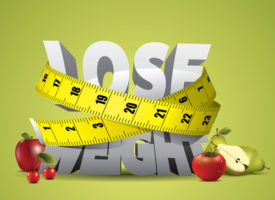Want to make yourself crazy, I mean really wacko? Read all the diet information out there and try to figure out which weight loss diet is the best.
Too Many Weight Loss Diets!
One popular solution for weight loss is the low-carb diet started by Dr. Atkins, who never saw a fat he didn’t like and shunned all carbohydrates. On the other side of the coin are the high-carb advocates who boycott fats and focus mainly on fruits, vegetables, and grains as energy sources. Another current trend is the Paleo Diet, which excludes grains, legumes, dairy, and potatoes. If that’s not enough to drive you crazy, there’s a new diet book every week, not to mention the golden oldies that resurface periodically, such as food combining (don’t eat carbohydrates and proteins at the same meal) and single-food diets (juice, grapefruit, cabbage soup, etc.).
Are you pulling out your hair yet? To help you sort through all these solutions for weight loss, let me tell you where I stand on diet.
How Your Body Metabolizes Food
It all centers on how your body metabolizes food. Carbohydrates are broken down in the digestive tract into glucose or other simple sugars, which are then absorbed into the bloodstream. This stimulates the pancreas to produce insulin, which moves glucose into the cells. Glucose is used for energy, and excesses are converted into glycogen and stored in the liver and muscles for future use. When these storehouses are full, the excess glucose is converted into fat and stored in fat cells.
Now let’s look at fats. During digestion, fats are emulsified by bile acids and further broken down by digestive enzymes, absorbed by the lymphatic system, released into the bloodstream, and carried to fat storage depots throughout the body. Whereas there’s very little storage capacity for carbohydrates, your body’s capacity for fat storage is almost limitless.
Proteins are broken down by the digestive system into amino acids and released into the bloodstream. The body uses amino acids to synthesize new proteins for cellular repair and growth, as well as functional proteins like enzymes and hemoglobin. Unlike carbohydrates and fats, the body does not store proteins. Some are converted into metabolic fuels and used as energy, but most excess proteins are broken down into uric acid and urea and excreted in the urine.
Weight Loss Is About Burning Energy
Finally, and most important for weight loss, let’s examine how the body burns energy. The preferred high-octane fuel is carbohydrate in the form of glucose. Between meals, when there’s no fresh supply of glucose in your blood, energy is derived from your glycogen stores. Once these limited stores are exhausted, the burning of fat starts in full force.
Your overnight fast—the 10 to 12 hours between dinner and breakfast—is ample time for your body to have depleted most of its carbohydrate stores. (More on this below.) When you replenish those stores at breakfast with cereal, toast, etc., you continue to burn carbohydrates. However, if you do not replenish them by eating carbohydrates, you will shift into fat-burning mode.
Stored fat isn’t burned as efficiently as glucose, particularly when the body is burning only fat. This produces carbon compounds called ketones as a byproduct. Ketones also are used as fuel, but when they accumulate in the blood faster than they can be used, they are “wasted,” expelled via the urine and lungs. Expelling ketones is like putting logs on the fire, allowing them to burn three-quarters down, then throwing away the still-burning logs and replacing them with new ones. Obviously, you’ll burn up more wood this way. When you’re throwing off half-burned logs, you’re depleting your fat stores.
A Shortcut to Rapid Weight Loss
This is one reason the very low-carbohydrate weight loss diet works for so many people. By not replenishing their carbohydrate stores, they stay in the fat-burning mode.
It also works because it reduces insulin production. Insulin is a storage hormone. It not only lets glucose into the cells, but it also helps fat get in. Obesity, particularly in the abdominal area, is a marker for elevated levels of insulin in the blood and for insulin resistance, which encourages the production of more and more insulin. Hypertension and high levels of cholesterol, triglycerides, and blood sugar levels are also markers of insulin resistance.
The foods that stimulate the highest production of insulin are carbohydrates, particularly rapidly digested refined carbohydrates like flour and sugar. Protein foods provoke some insulin response, but it is far less than that of carbohydrates, and fat doesn’t stimulate the release of insulin. Therefore, eating a low-carb diet dramatically decreases insulin production.
Finally, a low-carbohydrate diet reduces food intake, because it substantially curbs appetite. Furthermore, it prohibits you from eating chips, cookies, candy, bread, and other high-carb, high-calorie foods.
The Most Effective Weight Loss Diet
Weight loss is about burning up stored fat. If you can achieve this, you’ll lose weight, no matter what diet you follow. That said, the most effective weight loss diet I’ve come across to date—and the one we recommend to our patients at Whitaker Wellness—is the mini-fast with exercise.
This program takes advantage of the natural overnight fast while sleeping and adds exercise in the morning so you’ll use up your remaining glycogen stores and begin burning fat. Burning fat for energy instead of glucose results in long-term, sustainable weight loss—and the mini-fast with exercise is an easy-to-stick-with regimen that can be continued indefinitely.
Effective Solutions for Weight Loss Recap
To learn more, read my book The Mini-Fast Diet, available in bookstores, online, or by calling (800) 810-6655.
To learn more about the Whitaker Wellness Institute’s safe and natural solutions for weight loss, call (866) 632-8890 or fill out this form for a complimentary consultation with one of our friendly and knowledgeable Patient Services Representatives.


